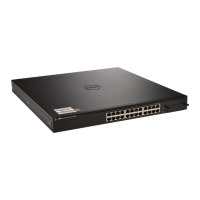154 Managing a Switch Stack
If your switch stack performs VLAN routing, another way to take advantage of
NSF is to configure multiple “best paths” to the same destination on
different stack members. If a unit fails, the forwarding plane removes Equal
Cost Multipath (ECMP) next hops on the failed unit from all unicast
forwarding table entries. If the cleanup leaves a route without any next hops,
the route is deleted. The forwarding plane only selects ECMP next hops on
surviving units. For this reason, try to distribute links providing ECMP paths
across multiple stack units.
Why is Stacking Needed?
Stacking increases port count without requiring additional configuration. If
you have multiple PowerConnect switches, stacking them helps make
management of the switches easier because you configure the stack as a single
unit and do not need to configure individual switches.
Default Stacking Values
Stacking is always enabled. By default, the 10G SFP+ ports are in Ethernet
mode and must be configured to be used as stacking ports. Ports that are
configured in stacking mode show as “detached” in the output of the show
interfaces status command.
Configuring an Ethernet port as a stacking port changes the default
configuration of the port. The port stacking configuration does not show in
the running-config. To determine the stacking configuration of a port, use the
show switch stack-ports command.
NSF is enabled by default. You can disable NSF in order to redirect the CPU
resources consumed by data checkpointing. Checkpointing only occurs when
a backup unit is elected, so there is no need to disable the NSF feature on a
standalone switch. When a new unit is added to the stack, the new unit takes
the configuration of the stack, including the NSF setting.

